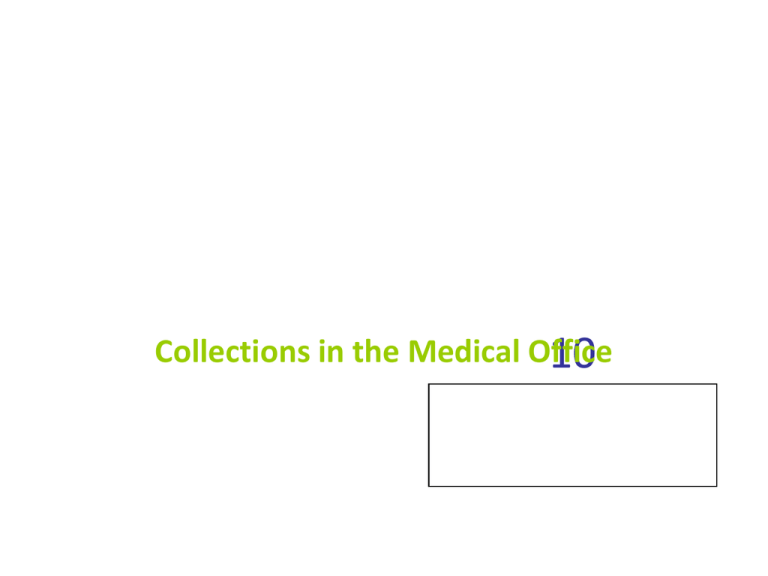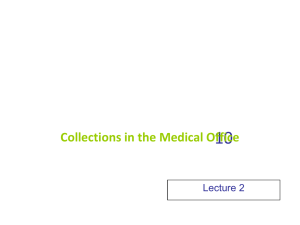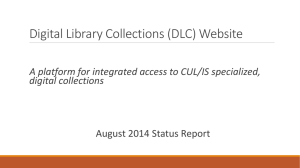10-2
advertisement

Collections in the Medical Office 10 Learning Outcomes 10-2 When you finish this chapter, you will be able to: 10.1 10.2 Explain the importance of prompt payment laws. Summarize the importance of a financial policy in a medical office. 10.3 Identify the laws that regulate collections from patients. 10.4 Demonstrate how to post a payment from a collection agency. 10.5 Discuss the process of writing off uncollectible accounts. 10.6 Explain how to use a patient aging report to identify past due accounts. Learning Outcomes (Continued) 10-3 When you finish this chapter, you will be able to: 10.7 10.8 10.9 Demonstrate how to add an account to the collection list. Demonstrate how to create a collection letter. Demonstrate how to create a collection tracer report. Key Terms • • • • • • • • collection agency collection list collection tracer report payment plan prompt payment laws tickler uncollectible accounts write off 10-4 10.1 Laws Governing Timely Payment10-5 of Insurance Claims • Receiving prompt payment for services is a critical factor in determining the financial success of a medical practice • Prompt payment laws are state laws that mandate a time period within which clean claims must be paid and that call for financial penalties to be levied against late payers 10-6 10.2 The Importance of a Financial Policy • Collection process begins with a clear financial policy and effective communications with patients about their financial responsibilities • Important to have a written financial policy that spells out patients' responsibilities 10.2 The Importance of a Financial Policy (Continued) 10-7 • Financial policies should tell patients how the practice handles: – Collecting copayments and past-due balances – Setting up financial arrangements for unpaid balances – Providing care for patients with low incomes – Payments for services not covered by insurance – Collecting prepayments – Accepted methods of payment 10-8 10.3 Laws Governing Patient Collections • Patient collections are consumer collections and are regulated by federal and state laws • Collections from insurance carriers are considered business collections 10.3 Laws Governing Patient Collections 10-9 (Continued) • Fair Debt Collection Practices Act of 1977 • Telephone Consumer Protection Act of 1991 • General guidelines: – No calls before 8 am or after 9 am – No threats or profane language – Respect patient privacy – No deception or violence 10.3 Laws Governing Patient Collections 10-10 (Continued) • A payment plan is an agreement between a patient and a practice in which the patient agrees to make regular monthly payments over a specified period of time – Truth in Lending Act applies if practice adds finance charges and payments are made in more than four installments 10-11 10.4 Working with Collection Agencies • A collection agency is an outside firm hired to collect on delinquent accounts – Practice no longer contacts the patient if the account is turned over to a collection agency – Often paid on the basis of the amount of money they collect • When payment is received from a collection agency, it must be posted to the patient’s account – Information found on the statement provided by the agency • Exercise 10-1 10-12 10.5 Writing Off Uncollectible Accounts • When all collection attempts are exhausted, the collection process is ended • Amount owed is often called an uncollectible account or a bad debt, and it is written off the practice’s expected accounts receivable • A write off is a balance that has been removed from a patient’s account • Exercise 10-2 10.6 Using a Patient Aging Report for10-13 Collections • An aging report shows the patient’s chart number and name, and the amount of unpaid charges in each of these categories: – Current: Up to 30 days – Past: 31 to 60 days – Past: 61 to 90 days – Past: 91 to 120 days – Past: More than 120 days • Exercise 10-3 10.7 Adding an Account to the Collection List 10-14 • Overdue accounts are added to a collection list • The collection list is designed to track activities that need to be completed as part of the collection process – Ticklers or collection reminders are displayed as collection list items • A tickler is a reminder to follow-up on an account that is entered on the collection list 10.7 Adding an Account to the Collection List (Continued) 10-15 • The Collection List dialog box displays ticklers that have been entered into the database 10.7 Adding an Account to the Collection List (Continued) • Tickler Item dialog box • Exercise Tickler tab10-4 Office Notes tab 10-16 10.8 Creating Collection Letters • Before collection letters can be sent in Medisoft: – Patient-responsible tickler item must be entered in the collection list – Collection Letter report must be created • Report is generated when the Patient Collection Letters option is selected on the Reports menu 10-17 10.8 Creating Collection Letters (Continued) • The Patient Collection Report lists patients with overdue accounts to whom statements have been mailed 10-18 10.8 Creating Collection Letters (Continued) • After printing collection letters, an account alert appears in the Transaction Entry, Quick Ledger, and Appointment Entry windows • There are three account alert abbreviations: – RB – remainder balance – DP – delinquent on payment plan – IC – in collections • Exercise 10-5 10-19 10-20 10.9 Creating a Collection Tracer Report • A collection tracer report is used to keep track of collection letters that were sent • The report lists: – – – – – – Tickler item number Responsible party Chart number Account balance Date collection letter was sent Reasons the account is in collections • Created via the Collection Tracer Report feature on the Reports menu • Exercise 10-6











